 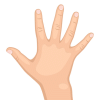
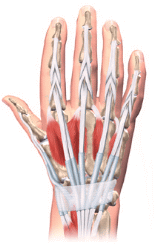 Your hand is a complicated system of bones, muscles, nerves, tendons, ligaments, and blood vessels. Your hand includes your palm, fingers and thumb. Fingernails are made of a tough protein called alpha-keratin, a polymer also found in the claws, hooves and horns of other vertebrates.
Your hand is a complicated system of bones, muscles, nerves, tendons, ligaments, and blood vessels. Your hand includes your palm, fingers and thumb. Fingernails are made of a tough protein called alpha-keratin, a polymer also found in the claws, hooves and horns of other vertebrates.Opposable thumbs can be moved to touch the tips of other fingers on the same hand. This allows for a variety of grasping and manipulating actions. Humans have longer thumbs relative to their fingers than other primates, which allows for a stronger grip with more control. 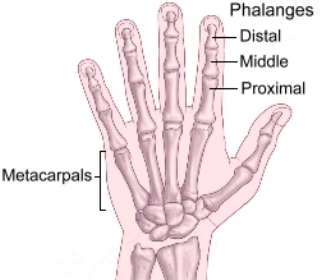 Bones provide the structural support in your hand and wrist. They give them their shape and are the anchors that other components are connected to.
Bones provide the structural support in your hand and wrist. They give them their shape and are the anchors that other components are connected to.There are 19 bones in each of your hands. They’re grouped together by their location and function: The bones that are in your palm and give it its shape. The individual bones that make up the segments of your fingers and thumb. Small bones embedded in your tendons that help them move 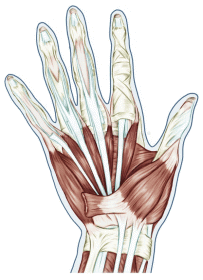 Muscles are soft tissue made of stretchy fiber. Muscles inside your hand work with muscles near the outside of your hand and in your forearm to give your hand its strength and dexterity.
Muscles are soft tissue made of stretchy fiber. Muscles inside your hand work with muscles near the outside of your hand and in your forearm to give your hand its strength and dexterity.There are 34 muscles in each of your hands. They are divided into groups: Muscles that control your thumb. You can feel them bulge at the base of your thumb in the palm of your hand. These line the outer edges of your palm on the outside of your pinkie finger. They control the area of your hand opposite your thumb. Between the metacarpal bones in your palm, they help your fingers move side-to-side. Lumbrical muscles are at the base of your fingers. They help you flex them. Your hand muscles can give you two types of grip: This gives your grip strength, useful for picking up heavy objects or opening jars. Precision is using your hand and fingers to move or touch smaller objects. Precision grip uses your fingers’ ability to meet your thumb to hold something between them. Picking up a pencil and turning a key in a lock are precision grip motions. 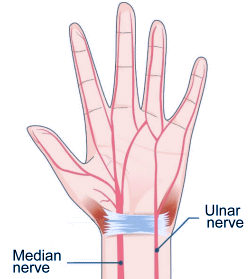 Nerves control your muscles, and help feel and process sensations, including touch, temperature, pain and pressure.
Nerves control your muscles, and help feel and process sensations, including touch, temperature, pain and pressure.Three main nerves give your hand and wrist sensation: All three of these nerves are connected to many branches of smaller nerves that spread out from the wrist into your hand and onto the fingers and sensory receptors in the skin. 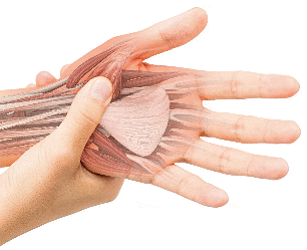 Tendons link your muscles to your bones. They’re like strong, flexible ropes. Your hand and wrist have two groups of tendons:
Tendons link your muscles to your bones. They’re like strong, flexible ropes. Your hand and wrist have two groups of tendons:Tendons that help you extend and straighten your fingers, hand and wrist. 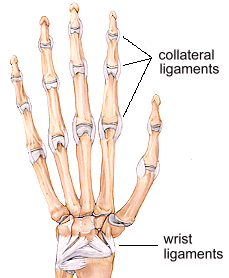 Ligaments are the other type of connective tissue in your hand. If tendons are like ropes, ligaments are more like thick tough rubber bands. Their min function is to connect the bones, to support them and keep them in place.
Ligaments are the other type of connective tissue in your hand. If tendons are like ropes, ligaments are more like thick tough rubber bands. Their min function is to connect the bones, to support them and keep them in place.Their functions also include: There are six types of ligaments in your hand. Here are a few: These run down the outside edges of your fingers and thumb. They protect your joints from moving too much from side to side. Volar plate ligaments connect your first two finger bones (phalanges) together on each finger. They run under your bones on the palm side of your hand and keep your fingers from bending too far back when you extend them. Your palmar fascia is a thick, triangle-shaped ligament-like structure that runs under the skin of your palm. The narrow point of the triangle is at your wrist, and it gets wider toward the base of your fingers. It helps your hand keep its shape while you move it and prevents your skin from sliding when you’re holding something. 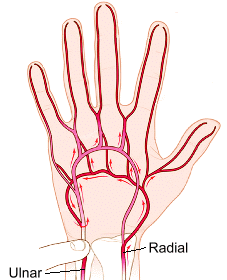 Arteries are blood vessels carrying blood and oxygen from the heart. Your hand and wrist get blood from two arteries.
Arteries are blood vessels carrying blood and oxygen from the heart. Your hand and wrist get blood from two arteries. These arteries communicate with each other in 'arches' that form in your hand. There’s both a a superficial and a deep arch in your hand. Vessels branch off the arches and supply blood to your fingers. 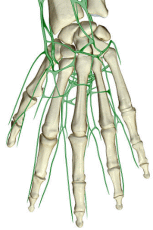 The Lymphatic system is a network of tissue, vessels and organs that collect excess plasma from your bloodstream and redistribute it throughout your body.
The Lymphatic system is a network of tissue, vessels and organs that collect excess plasma from your bloodstream and redistribute it throughout your body. Tiny capillaries in your hand capture extra plasma from the blood vessels that supply your hand and wrist. They connect to bigger lymph nodes and vessels in your upper arm. Problems Many issues can cause hand or wrist pain. Some of the most common conditions that affect your hand and wrist include:
|